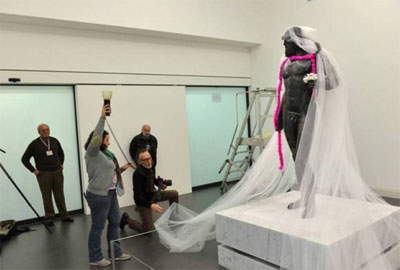Riace bronzes with boas and loincloths: whose responsibility is it?
We have already discussed that the Riace bronzes adorned with boas and leopard-print loincloths create more harm than good for the fight against homophobia: adorning ancient statues according to the most boorish homosexual stereotypes, in fact, does not help the cause in any way. There is, however, another very important issue to ponder: that of technical responsibilities.
In fact, on the Dagospia website, the first to report the news of the shots of the agaged Riace bronzes (dating back to last February), we read that Gerald Bruneau, the author of the photographs, allegedly “deceptively broke into” the National Archaeological Museum of Reggio Calabria. The question then is: but how is it possible to sneak into a museum and especially into a hall that is subject to a strict protocol that controls access? We read, in fact, from the website of the Superintendence for Archaeological Heritage of Calabria: “Access to the Hall of the Riace Bronzes is allowed only to groups of a maximum of twenty people at a time and is subject to time limitations, according to the following schedule: stop for 20 minutes in the pre-filter room, during which a video will entertain the public with updates on the state of research on the Riace bronzes; stop for about 3 minutes in the filter room; visit to the Bronzes of about 20 minutes; exit. Entry times: from 9:10 a.m. every twenty minutes, approximately every hour at 10, 30 and 50 minutes. These rules are to be strictly observed.” The room then undergoes an advanced climate control system, as we read from the website of the National Archaeological Museum, hosted on that of the Superintendence: “The room that houses the Bronzes is equipped with a climate control system, maintained on 20 ° in winter, 25-27 ° in summer, with a humidity rate of approximately 35-40%, that is, such as to prevent the triggering of new corrosion phenomena.”
 |
| Shots of the Riace bronzes in gay stereotype version. Photo taken from Dagospia |
So, if the above rules “are to be strictly adhered to,” how was it possible to allow not only an overrun of the hours (we don’t believe at all that 20 minutes was enough to “make up” the statues, set up the equipment, instruct the assistants, take photographs, disassemble the equipment, remove the “decorations”), but also to work, apparently without special care, in close contact with two very delicate statues? The superintendent, Simonetta Bonomi, made some statements to ANSA: Gerald Bruneau allegedly proposed to her to “take a shot of a statue with a white tulle behind it” (thus, this being the case, he would not have broken in under false pretenses, but with the endorsement of the authorities), and then changed his intentions without the superintendent’s knowledge. Again according to Simonetta Bonomi, the janitors noticed this and blocked Bruneau, but the photographer still made it in time to take several shots.
Whose responsibility then? The custodians should have been watching Bruneau the whole time: how could they not have noticed that he was about to intervene on the statues by “dressing” them in boas and loincloths? This is an operation that cannot be conducted in a matter of seconds: the custodians should have stopped Bruneau immediately, and the photographer should not have even had the material time to place the boa around the statue’s neck. Not least because the custodians should have been fully and adequately informed of how the shots were to be taken and the interventions to be conducted inside the room. Whose shortcomings, therefore, are they? Whose responsibility is this? We hope that full light will be shed on an affair that, in addition to ridiculing and trivializing in a disarming way the cause of homosexuals, casts several shadows on the work of the superintendence: and this is all the more negative if we think about the fact that precisely in these days the reform of MiBACT is being discussed, which should revise the role of the superintendencies.
Warning: the translation into English of the original Italian article was created using automatic tools. We undertake to review all articles, but we do not guarantee the total absence of inaccuracies in the translation due to the program. You can find the original by clicking on the ITA button. If you find any mistake,please contact us.




























